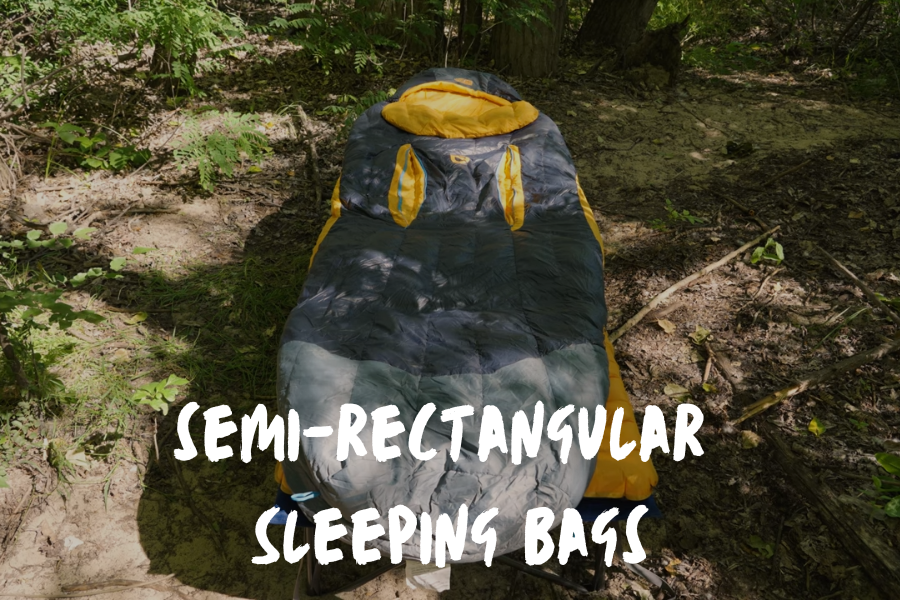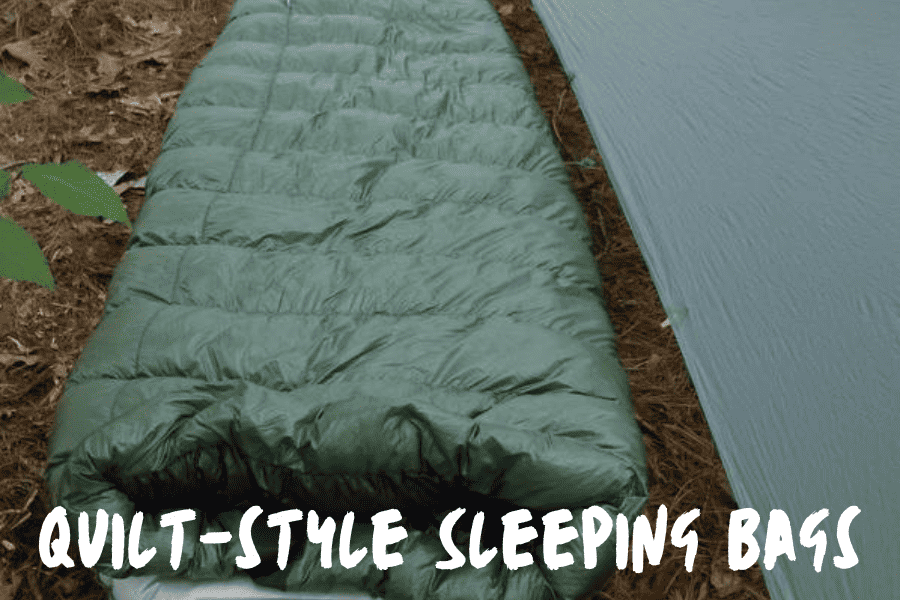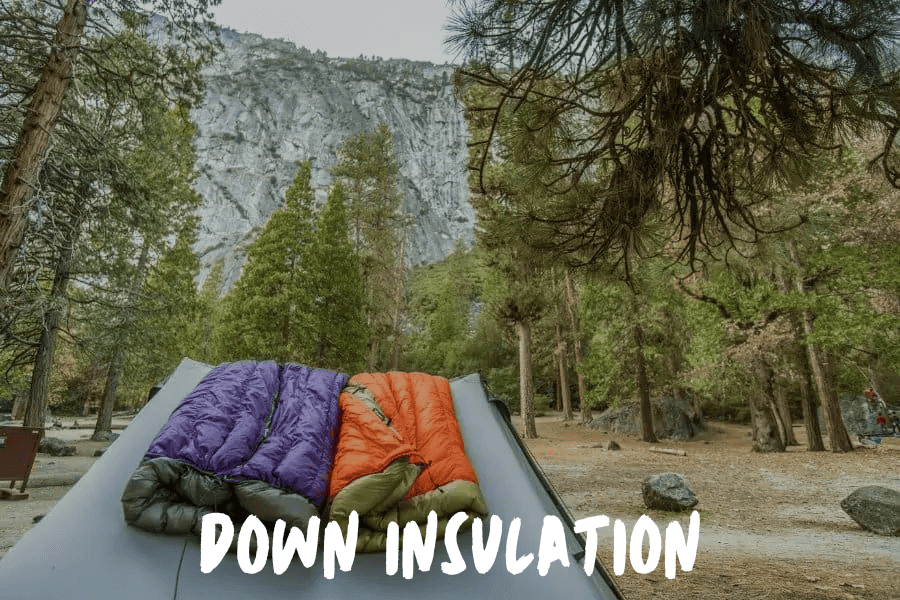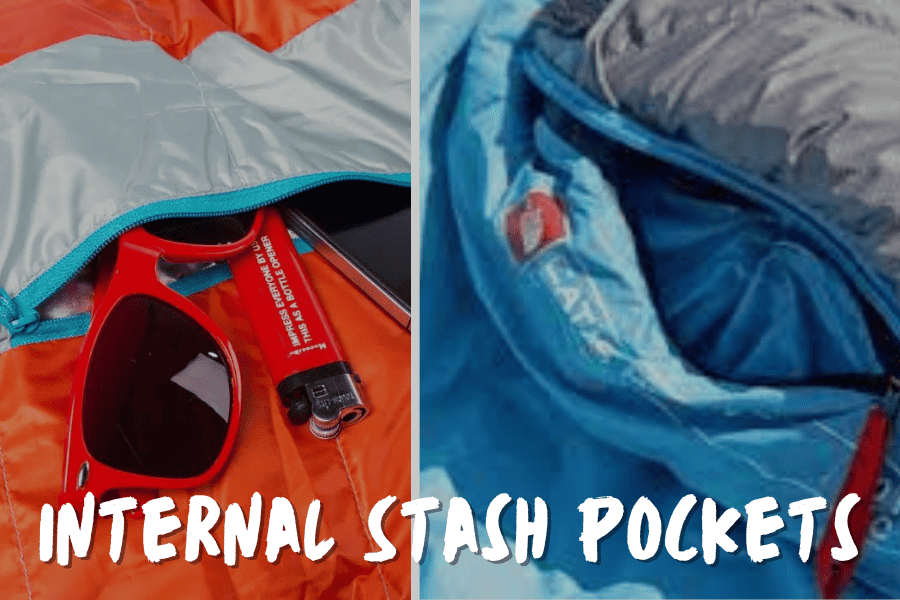Buying a sleeping bag is an exciting, but also daunting task.
With so many models available, how does one choose?
Well, there are a lot of factors you need to take into consideration when picking the perfect sleeping bag.
And today, we’ll cover them all.
Let’s dive in.
What To Look For In A Sleeping Bag
When buying a sleeping bag, our eyes instantly go to colors and shapes. But that doesn’t even scratch the surface when it comes to important factors in choosing.
Every single model is designed with specific conditions in mind.
First, the weather you’re camping in determines how warm your sleeping bag needs to be.
Then, your budget, weight limit, and sleeping style also determine the type of sleeping bag you need.
Also, don’t forget to match the sleeping bag size to your own body height.
Finally, we have additional features that make certain models stand out from the crowd.
Still confused? Let’s talk about each characteristic individually…
Temperature Rating

When choosing a sleeping bag, one of the first things you should be wondering about is whether it will keep you warm.
And to answer that question, look at the model’s temperature rating.
But to an untrained eye, that might be easier said than done.
True, sleeping bag temperature ratings were standardized several years ago.
This means all manufacturers grade their products using predetermined, lab-tested, established temperature ratings.
Each sleeping bag has three different ratings: comfort, lower limit, and extreme temperature levels.
The comfort level indicates a temperature at which an average cold sleeper can sleep comfortably at night.
This is the rating used for women’s sleeping bags, since an average woman will feel colder compared to an average man in the same sleeping bag.
That’s actually scientifically proven! Women have lower muscle mass, so they give off less heat than men.
The lower limit rating is the one used on men’s sleeping bags, and it refers to the temperature at which an average warm sleeper might still feel comfortable.
Finally, we have the extreme rating, which is the survival rating for an average cold sleeper (and women).
So, when choosing a sleeping bag, look at the rating that is more appropriate for the kind of sleeper you are.
To be safe, it’s always better to choose a sleeping bag with a temperature rating a few degrees colder than the lowest temperature you expect on your camping trip.
That way, you’re also prepared for unexpected temperature drops.
If it gets too warm, you can always unzip the sleeping bag to cool down during warmer nights.
| Sleeping Bag Type | Temperature Rating |
| Summer | 30°F+ |
| 3-season | 15°F to 30°F |
| Winter | 15°F and lower |
Sleeping Bag Shape
Of course, there are many other factors that you need to take into consideration when choosing a sleeping bag.
The next one is its shape, and you have quite a few options available.
Mummy Sleeping Bags

This type of sleeping bag resembles the shape of the Egyptian mummy coffin – hence the name.
The snug fit of this sleeping bag serves to minimize dead space around your body and keep you as warm as possible.
However, that also means your movement inside the sleeping bag is rather restricted.
In order to turn to your side, you need to roll over with your sleeping bag – not inside of it.
Given the fit, mummy sleeping bags are most suitable for cold weather.
At the same time, the close cut also means lower weight, which is why mummy bags are a common option for backpackers.
Read: Mummy vs. Rectangular Sleeping Bags
Rectangular Sleeping Bags

As the name suggests, a rectangular sleeping bag has a rectangular, boxy shape.
This is the most common type of sleeping bag, and it’s typically used for recreational camping trips.
A rectangular sleeping bag offers plenty of room for you to sleep in your favorite positions.
In fact, when the temperature allows it, you can unzip and turn it into a proper blanket!
Of course, this type of sleeping bag has its drawbacks, as well.
The fact that it’s so spacy also means that there’s more material involved compared to a mummy sleeping bag.
For that reason, rectangular bags are heavier and bulkier.
Furthermore, the fact that there’s a lot of “unused air space” inside makes this type of sleeping bag less thermally efficient.
For that reason, it’s mostly used for camping during warmer months of the year.
Semi-Rectangular Sleeping Bags

A semi-rectangular sleeping bag is a hybrid between a mummy and a rectangular sleeping bag, offering a decent compromise between wiggle room and warmth.
This type of sleeping bag is slightly tapered in the shoulder area, wide at the middle and narrows down towards the bottom.
In other words, you have some room to switch between different sleeping positions, while the shape prevents air from escaping, thus keeping you warm.
Basically, a semi-rectangular sleeping bag is a good medium.
It sits right in the middle when it comes to warmth, weight, and space.
For that reason, it’s a good choice for camping from spring to fall.
Double Sleeping Bags

Double sleeping bags are for couples who want to sleep together while camping, just like at home.
Have you noticed how certain brands make their sleeping bags in two versions: with a right-hand or a left-hand zipper?
Well, these sleeping bags can be zipped together to create a double sleeping bag.
Clearly, a double sleeping bag is heavy and bulky.
But the fact that you’re sleeping next to your partner means you can keep each other warm, so that makes this type of sleeping bag a good choice for 3-season camping.
Quilt-Style Sleeping Bags

A quilt is basically a blanket with a footbox like the one a mummy bag has.
The reason behind such a design is that with proper insulation underneath you, you don’t need a sleeping bag that covers 100% of your body.
Therefore, a quilt saves up on bulk and weight by providing just enough material to cover the top of your body and your feet.
A quilt-style sleeping bag is basically a quilt with a zipper.
When unzipped, it works like a quilt. But zipping it at night provides better draft protection and increased warmth.
This type of sleeping bag is quite versatile, which makes it suitable for camping during three out of four seasons.
Read: Quilt vs Sleeping Bag – Which Is Better For Backpacking?
Sleeping Bag Insulation Type
Then, we have insulation. The two most common types of insulation are down and synthetic.
To make your choice between them a bit easier, let’s talk about each insulation’s advantages and disadvantages individually.
Synthetic

Synthetic insulation is made of polyester fibers which are packed together to form insulating air pockets.
These fibers are heavier and less compressible compared to down.
But what makes synthetic so great is the fact that it retains its insulating properties even when wet, and it dries down rather fast.
Since it’s a man-made product, synthetic insulation is also non-allergenic.
While allergy to feathers is not really common, those who do have such an allergy can safely use a synthetic sleeping bag.
Finally, synthetic insulation is more affordable compared to down, so it’s a great option for anyone who’s on a budget.
Down

Down is a layer of fine filaments laying between the goose’s skin and outer feathers.
Basically, down is a goose’s insulating layer, so it makes sense that it works well as a sleeping bag insulation, too.
Down is extremely lightweight and fluffy, but at the same time, it does a great job of trapping heat.
When comparing it to synthetic fibers, down provides the same warmth for much less weight.
Not just that, but down is much more compressible.
So, when not in use, you can pack your down-filled sleeping bag down to a rather compact size, which makes it great for storage.
However, this amazing warmth-to-weight ratio and impressive compressibility don’t come for free.
Down sleeping bags are generally way more expensive compared to synthetic ones.
It’s also worth noting that down loses its insulating ability when wet.
And since it takes a while for it to dry, that means your wet sleeping bag will be useless for the whole day.
Read: Down vs. Synthetic Sleeping Bags (Which is Better?)
How To Choose The Right Size Sleeping Bag

Sleeping bags come in different sizes, as well.
Well, that’s not the case with every single model on the market, but most of them offer at least two sizes to choose from: regular and long.
Certain brands go one step further and offer their models in an extra-long size, which is designed for people taller than 6 feet.
Finally, many models also come in a kid’s size, which is mainly designated for children up to 12 years old.
Now, why does the size matter, you might ask?
Well, having a sleeping bag that’s too short for you is just like using a small blanket.
And the more you try to squeeze in, the more you’ll press against the sleeping bag’s insulation, thus creating cold spots.
But using a sleeping bag that’s too long is not good either.
If you have too much unused space inside the sleeping bag, you’ll feel colder at night since your body won’t be able to heat it up.
Here is a handy chart to guide you in picking the right size for your height:
| Your Height | Sleeping Bag Size | Recommended Length |
| Under 5’0″ (152 cm) | Kids/Short | 66″-70″ (168-178 cm) |
| 5’0″-5’6″ (152-168 cm) | Regular/Women | 72″-78″ (183-198 cm) |
| 5’6″-6’0″ (168-183 cm) | Long | 78″-84″ (198-213 cm) |
| 6’0″-6’6″ (183-198 cm) | Extra-Long | 84″-90″ (213-229 cm) |
Additional Features & Accessories
Finally, we can’t forget about additional features and accessories that can make a huge difference between otherwise almost identical models.
Hood & Draft Collars

You can have a super-ultra thick and fluffy sleeping bag, but if it doesn’t seal in the heat, it won’t be warm.
This is the reason why most rectangular sleeping bags are designated for warmer weather.
Since they’re wide at the top, there’s nothing to prevent the heat from escaping through there.
But if you plan on camping during colder months, a hood and a draft collar are the two features that will keep you warm.
A sleeping bag hood has the same purpose as the one on your jacket: to keep your head warm.
Most hoods also feature a cinch that you can tighten to seal in the warm air.
As for the draft collar, that’s the baffle around your neck that’s typically found on sleeping bags with a lower temperature rating.
A draft collar, as the name suggests, prevents draft. In other words, it prevents cool air from getting in and warm air from getting out.
Many rectangular sleeping bags also feature a draft collar, but it’s much more effective on semi-rectangular and mummy bags.
Sleeping Bag Liners

Essentially, a liner is an inner bag for your sleeping bag that provides additional warmth.
Basically, adding a liner is a quick and easy way of making your sleeping bag warmer.
But that’s not all it does.
A liner also keeps your sleeping bag clean from dirt and body oils.
This means you’ll need to wash your sleeping bag less frequently, which ultimately prolongs its lifespan.
Of course, there are other benefits of having a sleeping bag liner, but they differ depending on the choice of material.
A silk liner is lightweight, soft, and suitable for both cold and warm weather.
It does a good job at insulating during colder nights, but it’s very breathable and absorbent when sleeping in it during warmer months.
However, it’s rather expensive.
Cotton is not the lightest or the most compact, but it’s one of the most durable options out there.
It’s also rather warm and affordable, making it a great choice for a liner.
Synthetic liners are lightweight, moisture-wicking, and breathable.
However, they do hold onto body oils and odor, so they require a bit of upkeep.
And as you know, frequent washing lowers their overall lifespan.
Finally, we have fleece. Fleece wins when it comes to warmth and comfort, but be prepared for some extra weight on your back.
Two-Way Zippers

Even on a not-so-warm night, being cocooned into a sleeping bag may feel like being in a sauna.
When that happens at home, my main trick to cool myself instantly is to uncover one leg.
I’m sure I’m not the only one!
But… How do you do that when you’re in a sleeping bag?
Well, that’s where two-way zippers come in.
A two-way zipper allows you to unzip the top or the bottom of your sleeping bag.
That way, you can adjust ventilation and make yourself more comfortable inside a sleeping bag.
Basically, it’s an easy way of letting some air inside your footbox while still having your neck covered.
Waterproof & Water-Resistant Materials

Not all sleeping bags are designed to resist water in the same way.
That makes sense – after all, sleeping bags aren’t exactly supposed to be used for sleeping in the rain without a shelter above your head.
But they need a certain level of water resistance, as you don’t want them to get soaked from a tiny bit of water on them.
Typically, the outer fabric of a sleeping bag is tightly woven and coated with a durable water-repellent (DWR) finish for additional water-repellent ability.
However, that won’t do much unless the sleeping bag also has taped seams that prevent water drops from passing through the stitching holes.
This is something to pay attention to when choosing a sleeping bag.
Internal Stash Pockets

Imagine finally getting all comfy and warm inside a sleeping bag, but then you remember you need something – like a hand cream or ear pods.
It can be really tough making yourself leave that comfort to search around the tent for the thing you need.
Well, that’s why inner pockets are so great. You can put your essentials inside, so they’re always close-at-hand.
Most pockets have zippers or Velcro tapes, preventing your stuff from falling out to the bottom of the sleeping bag.
FAQs
How Do I Choose Between A Down & Synthetic Insulated Sleeping Bag?
Well, it really depends on what features you prioritize.
If you’re looking for a very warm or lightweight sleeping bag, then down is a better choice.
If you have a limited budget or plan on camping in wet weather, then synthetic might be for you.
What Is The Importance Of A Sleeping Bag’s Temperature Rating?
A sleeping bag with an inadequate temperature rating will be either too hot or too cold.
And while you can usually cool off by unzipping the sleeping bag, making it warmer is impossible without additional gear.
Are There Specific Sleeping Bags Designed For Women?
Yes, many sleeping bag brands offer mummy and semi-rectangular sleeping bags specifically designed for women.
These models are usually wider at the hips and narrower at the shoulders, given the difference in body shape between men and women.
Furthermore, these sleeping bags usually come in short and regular sizes, while men’s sleeping bags come in regular and long.
Finally, women’s sleeping bags typically have more insulation, given that women are generally colder sleepers than men.
How Do I Determine The Right Size Sleeping Bag For My Height?
When choosing the right size, make sure there are a few extra inches at the bottom for your feet.
If unsure about the length, you can check out our size table in the article above.
How Can I Find A Balance Between A Sleeping Bag’s Weight & Warmth?
As you know, down insulation offers the best weight-to-warmth ratio.
But you can achieve similar results with synthetic insulation by choosing a mummy sleeping bag that has less material involved.
How Do I Properly Pack & Store My Sleeping Bag?
To properly pack and store your sleeping bag, you’ll want to first shake it out. Next, you’ll zip it up.
Then you’ll fold it in half and roll it up.
Finally, stuff it into your stuff sack, and compress the stuff sack. That’s that!
Read: Stuff Sack Vs Compression Sack: Which is Best?
To Sum Things Up
When choosing a sleeping bag, there are many factors to take into consideration, from the weather you’ll be camping in, to your preferred sleeping style.
But the good thing is – there’s a suitable sleeping bag for every camper. You just need to know what to look for!


